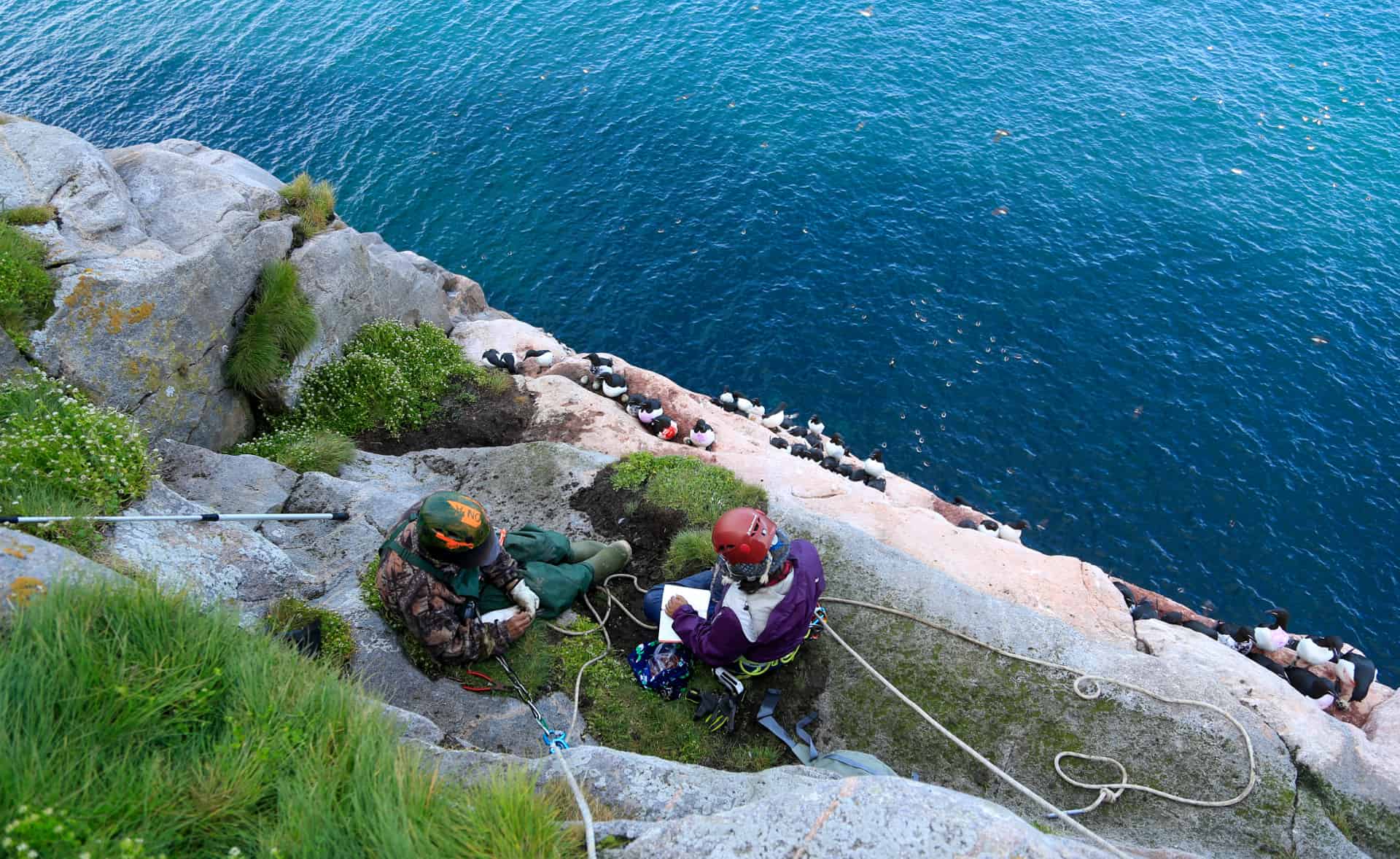Share this article
Wild Cam: ‘Forever chemicals’ affect murre reproduction
Hanging off cliffs a few hundred meters above Hudson Bay made for some great views. The deep blue of the water underneath contrasted with the white rock of the exposed cliffs and the emerald colors of the tufts of grass covering the less steep areas. But the real reason Emily Choy was spending two months in 2019 on Coats Island in Nunavut, Canada was to monitor a large colony of thick-billed murres that breed on the cliff sides.
Enlarge

Credit: Kyle Elliott
Choy, a postdoctoral fellow studying biology at McGill University in Montreal, had to take a rock-climbing course to conduct her research. But her rewards were idealistic scenes of nature, including a pod of roughly 200 beluga whales (Delphinapterus leucas) swimming in the waters beneath them. Nearby, about 100 walruses (Odobenus rosmarus) would haul out of the water to dry off and get some sun, making enough of a racket that Choy and her colleagues could hear several hundred meters away.
“It’s a really unique, amazing place to be,” she said.
Enlarge

Credit: Douglas Noblet
But the eggs and blood samples other researchers brought back in earlier years revealed that this ecological scene in northern Hudson Bay may be tainted by invisible pollution produced thousands of miles away. Long-lasting “forever chemicals” may be affecting the mass and reproduction of the thick-billed murres (Uria lomvia) during their breeding season, they found.
Forever chemicals refer to a larger group of chemicals called per- and polyfluoroalkyl substances (PFAS). Perfluoroalkyl acids (PFAAs) belong to that larger group. These include a wide range of chemicals used in commercial and industrial products—everything from the coating on cooking pans to water-resistant Scotchgard spray. The longer chain PFAS tend to be the most persistent.
These chemicals aren’t usually produced so far north, but can get into the ocean from land-based water supplies, eventually circulating through currents into remote parts of the Arctic. They can affect a number of animals, as discussed in the most recent issue of The Wildlife Professional. But this new research examines the impacts on thick-billed murres.
“We found significant relationships between these contaminants, the PFAAs, and thyroid hormones,” Choy said.
Enlarge

Credit: Kyle Elliott
Different researchers from Environmental Climate Change Canada have monitored the murres at Coats Island for about 40 years. When Choy and her team went there in June 2019, a small Twin Otter airplane dropped them off near the beach by the cliffs where the seabirds live. She and her colleagues had to hike a steep hill then pulley their gear up to their cabins near the top. They took blood samples from murres, measured their body conditions, weighed them, counted eggs and retrieved other data.
In a study published recently in Environmental Pollution, Choy and her colleagues examined some of the effects that these perfluoroalkyl acids have had on the Coats Island murres based on data pulled from 2016 to 2018—before Choy herself was there.
Enlarge

Credit: Douglas Noblet
The team found significant relationships between the level of long-chain PFAAs and thyroid hormones important in reproduction. They found disruptions of triiodothyronine (T3), which play important roles in metabolism, incubation and thermoregulation in seabirds. The T3 hormone, in particular, helps murres regulate their body heat so they can better incubate their eggs.
The disruption of this chemical affected males more than females, the researchers found. This is key because thick-billed murres share incubation duties, splitting their nest watch into roughly 12-hour shifts. However, Choy noted that since males tend to keep watch during the day when the researchers were out, their results may have been slightly skewed toward males.
The birds with more concentrations of PFAAs in their system also tended to hatch their eggs earlier, they found. Choy said this might be because there were more interruptions to incubation for those birds, but the exact reasons for this is unclear. The results also showed that birds with more long-chain PFAAs had lower body mass.
Enlarge

Credit: Douglas Noblet
Choy said that previous studies have shown relationships between PFAAs and reproduction, but this research more specifically describes the direct pathway.
Choy is concerned that the effects of PFAAs is just one among many problems affecting Arctic seabirds like thick-billed murres, including habitat disturbance from shipping and climate change. When Choy was on the island herself, she was studying the effects of heat stress on the birds, for example. “These birds are already under stress in terms of the impacts of arctic change,” she said.
Enlarge

Credit: Kyle Elliott
Header Image: Researcher Emily Choy releases a murre from a cliff on Coats Island. Credit: Douglas Noblet








